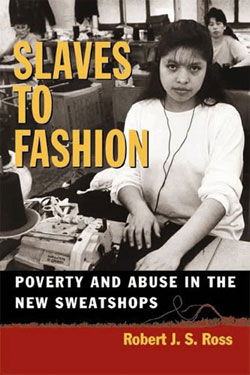“A brilliant and beautiful book, the mature work of a lifetime, must reading for students of the globalization debate.”
—Tom Hayden“Slaves to Fashion is a remarkable achievement, several books in one: a gripping history of sweatshops, explaining their decline, fall, and return; a study of how the media portray them; an analysis of the fortunes of the current anti-sweatshop movement; an anatomy of the global traffic in apparel, in particular the South-South competition that sends wages and working conditions plummeting toward the bottom; and not least, a passionate declaration of faith that humanity can find a way to get its work done without sweatshops. This is engaged sociology at its most stimulating.”
—Todd Gitlin“. . . unflinchingly portrays the reemergence of the sweatshop in our dog-eat-dog economy.”
—Los Angeles Times
 Just as Barbara Ehrenreich’s Nickel and Dimed uncovered the plight of the working poor in America, Robert J. S. Ross’s Slaves to Fashion exposes the dark side of the apparel industry and its exploited workers at home and abroad. It’s both a lesson in American business history and a warning about one of the most important issues facing the global capital economy-the reappearance of the sweatshop.
Just as Barbara Ehrenreich’s Nickel and Dimed uncovered the plight of the working poor in America, Robert J. S. Ross’s Slaves to Fashion exposes the dark side of the apparel industry and its exploited workers at home and abroad. It’s both a lesson in American business history and a warning about one of the most important issues facing the global capital economy-the reappearance of the sweatshop.
Vividly detailing the decline and tragic rebirth of sweatshop conditions in the American apparel industry of the twentieth century, Ross explains the new sweatshops as a product of unregulated global capitalism and associated deregulation, union erosion, and exploitation of undocumented workers. Using historical material and economic and social data, the author shows that after a brief thirty-five years of fair practices, the U.S. apparel business has once again sunk to shameful abuse and exploitation.
Refreshingly jargon-free but documented in depth, Slaves to Fashion is the only work to estimate the size of the sweatshop problem and to systematically show its impact on apparel workers’ wages. It is also unique in its analysis of the budgets and personnel used in enforcing the Fair Labor Standards Act.
Anyone who is concerned about this urgent social and economic topic and wants to go beyond the headlines should read this important and timely contribution to the rising debate on low-wage factory labor.
